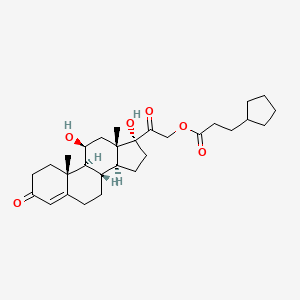



API Suppliers
0

US DMFs Filed
0

CEP/COS Certifications
0

JDMFs Filed
0
Other Certificates
0
Other Suppliers
0
0
0

USA (Orange Book)

Europe
0

Canada
0

Australia
0

South Africa
0
Uploaded Dossiers
0
U.S. Medicaid
0
Annual Reports
0
0
USFDA Orange Book Patents
0
USFDA Exclusivities
0
Blog #PharmaFlow
News
0
EDQM
0
USP
0
JP
0
Other Listed Suppliers
0
0


1. Hydrocortisone 21-cyclopentylpropionate
1. 508-99-6
2. Cortef Fluid
3. Cortisol 21-cyclopentanepropionate
4. Cortef Oral Suspension
5. Hydrocortisone Cipionate
6. Hydrocortisone Cyclopentylpropionate
7. Hydrocortisone Cyclopentyl Propionate
8. Cortisol, 21-cyclopentanepropionate
9. Nsc 10721
10. Nsc-10721
11. 4xdy25l70b
12. Chebi:5783
13. [2-[(8s,9s,10r,11s,13s,14s,17r)-11,17-dihydroxy-10,13-dimethyl-3-oxo-2,6,7,8,9,11,12,14,15,16-decahydro-1h-cyclopenta[a]phenanthren-17-yl]-2-oxoethyl] 3-cyclopentylpropanoate
14. Hydrocortisone 21.beta.-cyclopentanepropionate
15. 17-hydroxycorticosterone 21.beta.-cyclopentylpropionate
16. 17-(3-cyclopentyl-1-propionyl)-11beta,17alpha,21-trihydroxypregn-4-ene-3,20-dione
17. Pregn-4-ene-3,20-dione, 21-(3-cyclopentyl-1-oxopropoxy)-11,17-dihydroxy-, (11.beta.)-
18. Mls002638159
19. Unii-4xdy25l70b
20. Hydrocortisone Cypionate [usp]
21. Einecs 208-091-0
22. Hydrocortisone 21beta-cyclopentanepropionate
23. Chembl1549
24. Schembl41673
25. 17-hydroxycorticosterone 21beta-cyclopentylpropionate
26. Dtxsid90872930
27. Hydrocortisone Cypionate(200 Mg)
28. Nsc10721
29. Zinc4097470
30. Bdbm50371265
31. Hy-u00089
32. Lmst02030121
33. 11beta,17,21-trihydroxypregn-4-ene-3,20-dione 21-cyclopentanepropionate
34. Db14541
35. Hydrocortisone Cipionate [mart.]
36. Hydrocortisone Cypionate [vandf]
37. Hydrocortisone Cipionate [who-dd]
38. Nci60_000174
39. Hydrocortisone Cypionate [orange Book]
40. C08176
41. D00976
42. Q27106891
43. Pregn-4-ene-3, 21-(3-cyclopentyl-1-oxopropoxy)-11,17-dihydroxy-, (11.beta.)-
44. Pregn-4-ene-3,20-dione, 21-(3-cyclopentyl-1-oxopropoxy)-11,17-dihydroxy-, (11beta)-
45. 11,17-dihydroxy-3,20-dioxopregn-4-en-21-yl 3-cyclopentylpropanoate, (17.alpha.,21.beta.)
| Molecular Weight | 486.6 g/mol |
|---|---|
| Molecular Formula | C29H42O6 |
| XLogP3 | 4.7 |
| Hydrogen Bond Donor Count | 2 |
| Hydrogen Bond Acceptor Count | 6 |
| Rotatable Bond Count | 7 |
| Exact Mass | 486.29813906 g/mol |
| Monoisotopic Mass | 486.29813906 g/mol |
| Topological Polar Surface Area | 101 Ų |
| Heavy Atom Count | 35 |
| Formal Charge | 0 |
| Complexity | 918 |
| Isotope Atom Count | 0 |
| Defined Atom Stereocenter Count | 7 |
| Undefined Atom Stereocenter Count | 0 |
| Defined Bond Stereocenter Count | 0 |
| Undefined Bond Stereocenter Count | 0 |
| Covalently Bonded Unit Count | 1 |
For the relief of the inflammatory and pruritic manifestations of corticosteroid-responsive dermatoses. Also used to treat endocrine (hormonal) disorders (adrenal insufficiency, Addisons disease). It is also used to treat many immune and allergic disorders, such as arthritis, lupus, severe psoriasis, severe asthma, ulcerative colitis, and Crohn's disease.
Hydrocortisone is the most important human glucocorticoid. It is essential for life and regulates or supports a variety of important cardiovascular, metabolic, immunologic and homeostatic functions. Topical hydrocortisone is used for its anti-inflammatory or immunosuppressive properties to treat inflammation due to corticosteroid-responsive dermatoses. Glucocorticoids are a class of steroid hormones characterised by an ability to bind with the cortisol receptor and trigger a variety of important cardiovascular, metabolic, immunologic and homeostatic effects. Glucocorticoids are distinguished from mineralocorticoids and sex steroids by having different receptors, target cells, and effects. Technically, the term corticosteroid refers to both glucocorticoids and mineralocorticoids, but is often used as a synonym for glucocorticoid. Glucocorticoids suppress cell-mediated immunity. They act by inhibiting genes that code for the cytokines IL-1, IL-2, IL-3, IL-4, IL-5, IL-6, IL-8 and TNF-alpha, the most important of which is the IL-2. Reduced cytokine production limits T cell proliferation. Glucocorticoids also suppress humoral immunity, causing B cells to express lower amounts of IL-2 and IL-2 receptors. This diminishes both B cell clonal expansion and antibody synthesis. The diminished amounts of IL-2 also leads to fewer T lymphocyte cells being activated.
Absorption
Topical corticosteroids can be absorbed from normal intact skin. Inflammation and/or other disease processes in the skin increase percutaneous absorption.
Route of Elimination
Corticosteroids are metabolized primarily in the liver and are then excreted by the kidneys. Some of the topical corticosteroids and their metabolites are also excreted into the bile.
Primarily hepatic via CYP3A4
6-8 hours
Hydrocortisone binds to the cytosolic glucocorticoid receptor. After binding the receptor the newly formed receptor-ligand complex translocates itself into the cell nucleus, where it binds to many glucocorticoid response elements (GRE) in the promoter region of the target genes. The DNA bound receptor then interacts with basic transcription factors, causing the increase in expression of specific target genes. The anti-inflammatory actions of corticosteroids are thought to involve lipocortins, phospholipase A2 inhibitory proteins which, through inhibition arachidonic acid, control the biosynthesis of prostaglandins and leukotrienes. Specifically glucocorticoids induce lipocortin-1 (annexin-1) synthesis, which then binds to cell membranes preventing the phospholipase A2 from coming into contact with its substrate arachidonic acid. This leads to diminished eicosanoid production. The cyclooxygenase (both COX-1 and COX-2) expression is also suppressed, potentiating the effect. In other words, the two main products in inflammation Prostaglandins and Leukotrienes are inhibited by the action of Glucocorticoids. Glucocorticoids also stimulate the lipocortin-1 escaping to the extracellular space, where it binds to the leukocyte membrane receptors and inhibits various inflammatory events: epithelial adhesion, emigration, chemotaxis, phagocytosis, respiratory burst and the release of various inflammatory mediators (lysosomal enzymes, cytokines, tissue plasminogen activator, chemokines etc.) from neutrophils, macrophages and mastocytes. Additionally the immune system is suppressed by corticosteroids due to a decrease in the function of the lymphatic system, a reduction in immunoglobulin and complement concentrations, the precipitation of lymphocytopenia, and interference with antigen-antibody binding.


